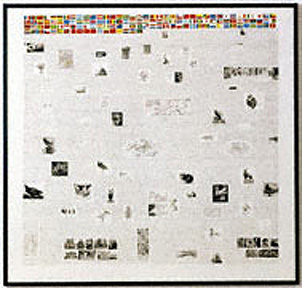
Gilles Barbier
French, 1965-
De "Cascadeur" á "chauffe-assiette" + errata (From "Stuntman" to "Plate-warmer"), 1994
copy work from dictionary, ink and gouache on paper
85 x 85 in.
SBMA, Museum purchase with funds provided by Wendy and Elliot Friedman and H. Smith Richardson III
2000.8a

Diana de Pont, SBMA curator of 20th c Art and Gilles Barbier, at the opening of his exhibition at SBMA on November 6, 1999.
COMMENTS
Copywork: The Dictionary Pages and Other Diversions by Gilles Barbier
SBMA Exhibition, November 6, 1999 - January 30, 2000
Composed of divese yet interrelated works produced over the past seven years, Copywork: The Dictionary Pages and Other Diversions by Gilles Barbier offers a fascinating glimpse into the mind of one of France's most aclaimed contemporary artists. Operating on three complementary levels, this exhibition features large-scale works-on-paper created by the artist fastidiously hand-copying pages from an illustrated Petit Larousse dictionary published in 1965, the year Barbier was born. It also presents miniature versions of all the dictionary pages and related Divertissements (Diversions) made to date, as well as a large-scale installation that fuly contextualizes The Dictionary Pages in an imagined architectural space.
Using ink and gouache, Barbier painstakingly transfers printed words and mechanically reproduced images that originally conformed to a standard-sized dictionary onto a large, square sheets of paper. Along the way, through deliberate action or unconscious accident, he strays from the originals. He then corrects these alterations with "errata" sheets that accompany the oversized duplicates. Occasionally, bored by the tedious copywork of the dictionary, he finds a welcome diversion in copying other printed and illustrated textx, most motably the weekly Télémagazine. Called Divertissements, these works are made in the same large and corresponding miniature formats as the dictionary pages.
For Barbier, the routine of copying began as a strategy for orchestrating delay, for taking "time out" from what he consideres his primary work, which is process-oriented multidisciplinary art. This repetitive, "mindless" activity freed him from the traditional demands to create and, as he says, allowed him to "mimc the artist who knows where he is going." As Barbier tells it, with irony, he did not know where to go or what to do when he graduated from art school in Marseille in 1992:" I was totally lost, without an ideas, so I began looking for a type of work that was like a game--something stupid or ridiculous. Copying in art is something stupid--there is no invention, no genius, no pretention . . . Having come across the dictionary in my library, I realized that it was the perfect choice, because it is itself a copy of reality viewed through a linguistic model."
Inspired by modern French art and post-WW-II French philosophy and criticism, The Dictionary Pages addresses the meaning of process and originality in contemporary art and the volue of multiplicity and linkage in our digitial information age.
from SBMA's View, January/February 2000, pp. 4-5.
Diana du Pont, Copywork: The Dictionary Pages and Other Diversions by Gilles Barbier, Exhibition Catalogue including CD-ROM, Santa Barbara
